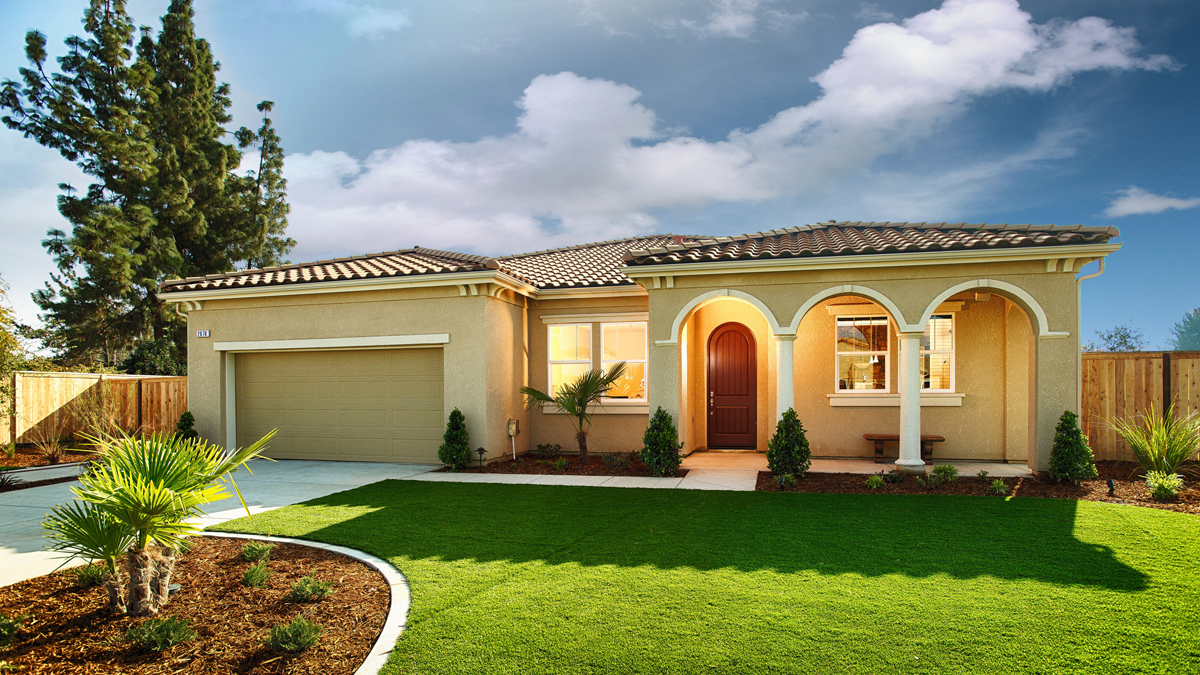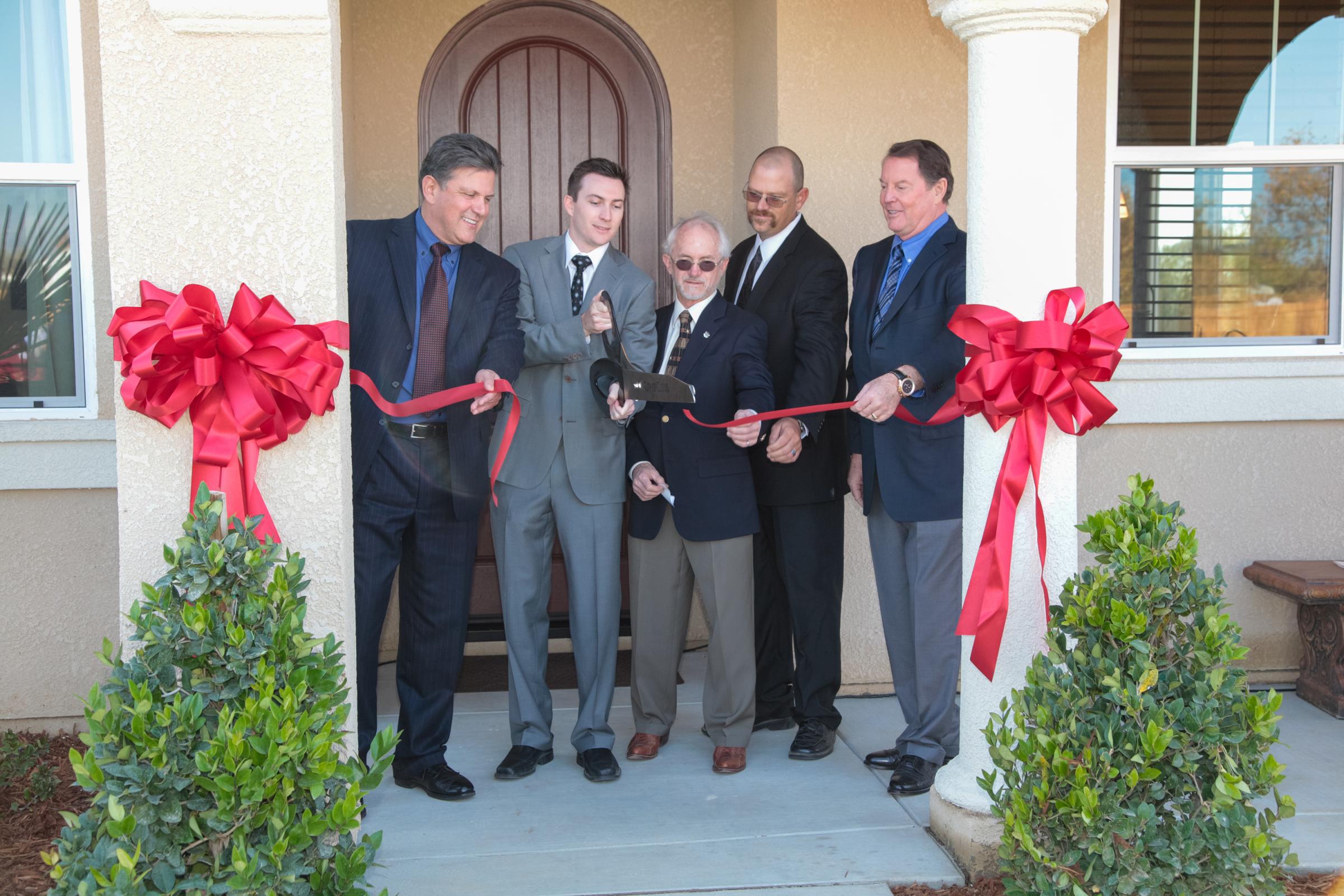Project Subtitle:
Project Description:
De Young Properties designed and built a Zero Net Energy (ZNE) home in Clovis, CA. The ZNE-design goal was set at source-energy ZNE [1] during the design stage. The source-energy ZNE criterion requires the home to produce as much energy as it consumes on a net, annual basis, with all energy, both consumed and generated, determined at the source (power-plant).
Considering costs, market, and sales, De Young used a standard plan for the ZNE, with increased energy-efficiency features. Iterative analyses of potential efficiency designs were provided by BIRAenergy [2] from which the team settled on the ZNE efficiency-features. Those energy-efficiency features alone, exclusive of the 6kW PV system on the roof, the home will use 64% less energy than if built to Title 24 requirements.
Air-sealing the envelope and moving ducts into conditioned space were among the most challenging elements of the ZNE design. To move ducts out of unconditioned space, De Young decided to drop the hallway ceilings to make duct-chases in the conditioned space. The final efficiency package was evaluated with the house as an entire system, and ensuring that the house-as-a-system met the source-energy ZNE goals set for this project at its inception. This systems analysis also led to requirements for inspections and tests of components and systems as the house was built. Thus, during the course of construction, BIRAenergy staff, De Young VP Operations, the site superintendent, and the third-party testing company made multiple visits to the De Young site to inspect the construction to verify the efficiency measures, and to test installations to ensure quality installation practices were employed. The home passed all of the many tests and inspections required by the design. In addition systems, such as the HVAC system were commissioned prior to completion of the home to ensure proper settings and function.
Energy analyses were performed using BEoptE+ v1.3 in Climate Zone 13, which includes Fresno and surrounds. The 6kW PV system on the rear and side roof-planes, in combination with the efficiency package, produce Source-Energy ZNE, and with the CEC-CPUC decision to define ZNE based on TDV, the home is a net producer of energy.
The Energy Performance Modeling process involved many parametric simulations of individual energy efficiency features to rank them by cost and impact, accompanied by selection and rejection of measures based on other builder concerns including availability, subcontractor knowledge or training needed for different features, and overall marketability. The selection of eligible features was followed by iterations of whole-house energy simulations that captured the interactions of the chosen features and provided measurement of progress toward the ZNE goal. This process again highly considered costs and practicality trade-offs, and required detailed discussions with the builder as well as contractors, vendors and other project stakeholders.
Moving ducts into conditioned space, and making the envelope tight produced the largest impacts, and were very cost-effective. While there are many permutations of efficiency features that can result in a ZNE design, the set developed with De Young is the result of an iterative design-development process that involved closely working with the builder to use features that they chose as the most cost-effective and marketable. The “final” design package included solar water heating, which was desired by the team, but modeling showed that equal energy-efficiency could be gained by replacing the solar water heating with a heat-pump water heater and one 250 W PV panel, at a cost savings of several thousand dollars. This was the last design decision made following many other iterations of: design, simulate, estimate costs, and evaluate, resulting in the final ZNE Package. Following this ZNE design process, De Young completed construction of the ZNE home in late 2013.
The embodied energy in a building can be calculated by summing estimates of embodied energy in the construction materials plus that due to the actual construction of the building [3]. The nine construction materials with the highest levels of embodied energy together account for 50% - 70% of the total embodied energy in the construction materials in the building. This partial estimate can then be factored up to estimate the energy embodied in 100% of the construction materials. The energy used in construction of the building is calculated using factors established for the type of building, and this energy is added to that of all the construction materials, producing an estimate of the total embodied energy of the home (see Table 2). For the De Young ZNE Home this embodied energy is 508,148 kBtu. BEoptE+ simulations of the De Young ZNE Home and the same plan built to meet Title 24 predict annual source energy savings of 147,180 kBtu/yr from the ZNE home, compared to that for the same building but with code-minimum efficiency features. This annual energy savings will recover the embodied energy in the ZNE home within 3.5 years.
[1] The resulting ZNE concept home is available for viewing in Clovis and is being monitored and evaluated by PG&E and De Young Properties to study its performance compared to simulations. After its first year, the home has successfully met our goal of offsetting all source energy consumed by the home.
At the start of this project, the units for determining ZNE (site, source or TDV) had not been standardized by the CEC and/or CPUC.
[2] BIRAenergy used the NREL BEoptE+ energy-modeling software to develop the ZNE design.
[3] This analysis uses the Survey Model Embodied Energy Calculator Model developed by the Advisory Council on Historic Conservation. See http://www.thegreenestbuilding.org/1979_ACHP_Energy_Conserv_and_Hist_Pres.pdf
Building Type Summary:
Other Awards:
Our company has received the prestigious Gold Nugget Award for Best NetZero Energy Home Design from the Pacific Coast Builders Conference (PCBC) in 2012 and an Award of Merit for Zero Net Energy Home Design from PCBC in 2013.
Address:
Elevation:
Lat. / Long.:
Location Type:
Climate Region:
Solar Insolation:
Annual HDD :
Annual CDD:
HDD Base Temp:
CDD Base Temp:
Occupancy Type and Details:
This is a concept model home used for public touring on a daily basis. Real-world consumption will vary once it is sold and occupied.
Multiple buildings?:
Historic?:
Completion date:
Materials:
Our ZNE home conforms to the stringent GreenPoint Rated checklist, administered by Build It Green, and was third-party verified to excel in all categories associated with sustainable home building.
Energy Highlights:
We now have 24 months of data since the home was completed in November 2013. According to Rob Hammon, our energy consultant for the project, the home did in fact achieve source-ZNE based on its first year of use as a model home. However, it has been a model home since completion so the data isn’t necessarily “real world”.
In addition, it’s important to note that even with real occupant data the results would vary greatly depending upon the family living in the home. We recently did a study looking at real-world consumption of our homes compared to the energy model for each floor plan used and found that the largest deviation above the model estimate of electric consumption was 41% and the largest deviation below the model estimate of electric consumption was 81%. A pretty astounding amount of deviation from the energy models!
I bring this point up because, as a production home builder, we’re never really going to be too concerned with how any one individual home actually performs relative to the energy model, or ZNE goal. Rather, it will generally be more important for us to look at the average of a group of homes we’ve built and see how that compares to our energy models and ZNE goals, since individual occupant consumption varies so greatly. Luckily, the same study I referenced above also showed, on average, our real-world homeowner consumption to be pretty consistent with our energy model predictions.
This definitely begs the question of how to market a ZNE home the best way since we won’t be able to guarantee every home will meet the ZNE model, and we’re working very diligently on this very important issue. Ultimately, we feel it will come down to the need for a very clear disclosure, perhaps like the fine print car companies use when listing gas mileage (“your mileage may vary”).
HERS Index:
Electric Utility Company:
Gas Utility Company:
Electricity amount (credited or exported to grid):
Net electricity usage (purchased electricity):
Subslab assembly:
Standard slab-on-grade concrete foundation.
Slab edge assembly:
Used no slab insulation as we are in a hot climate.
Flat attic assembly:
Truss framed attic with furnace/air handler mounted within. 30% of duct work remained in attic, but was buried in loose-fill fiberglass blow. The remainder was run below the thermal boundary.
Space heating - Manufacturer & Model:
Space cooling - Manufacturer & Model:
Domestic hot water - Manufacturer & Model:
Ventilation - Manufacturer & Model:
Published References:
The Business Journal: http://www.thebusinessjournal.com/news/energy-and-environment/9654-de-yo...
PG&E Currents: http://www.pgecurrents.com/2013/11/15/clovis-zero-net-energy-house-benef...
The Safety Channel: http://thesafetychannel.com/de-young-zero-net-energy-home-partner-interv...
Business Street Online: http://businessstreetonline.com/de-young-properties-zero-net-energy-home...
Business Street Online: http://businessstreetonline.com/de-young-properties-partners-with-solarc...
Jetson Green: http://www.jetsongreen.com/2013/11/a-zero-net-energy-prototype-house-bui...
Builder and Developer Magazine: http://bdmag.com/nov2011-40.php
Energy Use and Production Documentation:
Subslab R-value:
Slab edge R-value:
Above grade wall R-value:
Flat attic R-value:
Average window U-factor:
Solar Heat Gain Coefficient:
Visible Light Transmittance:
Air Changes per hour, ACH50:
Project Photos:




Site conditions:
Renewable Energy Sources:
Summary of enclosure strategy/description:
Typical single-family residential construction, with 2x4 16oc framing, slab-on-grade foundation, and concrete roof tile. We used high-density R-15 batt insulation in the walls along with a continuous layer of R-4 rigid insulation board on the exterior.
Roof Assembly:
Typical concrete roof tile assembly. Cool Roof concrete tile product was installed.
Window Description:
Monte Verde Windows: Vinyl, dual-pane, triple-layer low-E, argon gas-filled windows made by Anlin in Clovis, CA.
